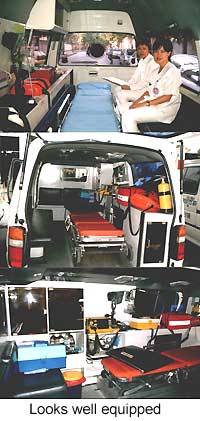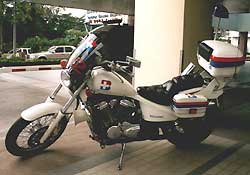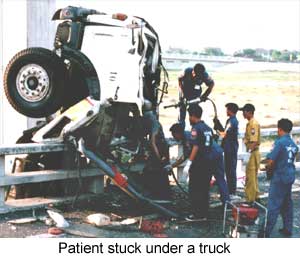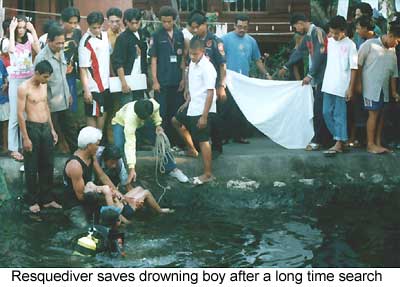<<<<<<<< Detta är arkivmaterial >>>>>>>> |
|
Encountering the prehospital care in Bangkok |
|
Ambulanssjuksköterskan Tobias Bergenblad har besökt Thailands huvudstad Bangkok och följt med deras prehospitala verksamhet. Här under kan du läsa om hans upplevelser och samtidigt f å lite träning i engelskan:-). Redaktionen Typical for developing countries, like Thailand, is that they are only beginning to consider the importance of emergency medicine and prehospital care. The number of incidence of medical emergencies have been very high in Thailand for a long time. Now when the economic development and urbanization are currently increasing the emergency medicine and prehospital care have never played a bigger role in Thailand than now. The top two reported causes of death in Thailand are especially relevant to emergency medicine. Heart disease related deaths rank first (69,2 deaths per 100 000 people per year in 1995). Injuries and poisonings rank second. No legislation exists in Thailand to develop an effective prehospital care, PHC, system. Annual economic losses from motor vehicle crashes were estimated 1996 to 360 million dollar which is nearly double the amount of the entire budget of the Ministry of Public Health.
For example, in Bangkok, traffic and safety laws are primarily a responsibility of the Interior Ministry. Jurisdiction over highway/traffic accidents belongs to the Bangkok Metropolitan Administration (BMA). Responsibility of PHC system development falls under the Ministry of Public Health, Department of Medical Service. There seems to be a lot of prestige and bureaucracy with in these administrative entities and no one seems to be willing to start negotiating with each other to perform a functioning PHC service. Once a centralized plan for Bangkok is made maybe the rest of the country will follow. Traffic If you try to talk to a taxi-driver and he doesn"™t seem to speak a single word of English, just say - Bangkok, much traffic!! He will then laugh and try to show you his skills in maneuvering the traffic while you are closing your eyes and trying to hold on to what ever you can wondering way you ever opened your mouth in the first place. There are usually no seatbelts in the backseat. I might have missed it but I can not recall that I ever saw one single sign of speed-limitation in the city. That too is remarkable because if you go on the express/highway you might get up to a speed of 90-100km/hour. To us in the western world that doesn"™t seem to be very much but the conditions in Bangkok is quite different. You might have a motorcycle on one side of your car with four passengers on it (two adults and to infants) with absolutely no protected gear on (including no helmets) and on the other side a typical "tuk tuk" (a form of motorcycle with three wheels and a small roof packed with people as well). The number of incidents with motorcycle crashes are very high in Bangkok and the outcomes are usually disastrous. Impulsive drivers are a big risk also. Everyone wants to get ahead to find the most winning lane to go as fast as possible. The combination of impulsive drivers and motorcycles that waves between cars to cut time are a dangerous one. There are a resent law that says that as a driver of a motorcycle you should wear a helmet and there are actually some that do but the most do not. As a passenger on a motorcycle there are no such laws. In 1993, there were more than 7.2 million registered motorcycles in the nation, compared with 1.6 million cars. Traffic in Bangkok is so problematic that a "midwives on motorcycles program" was instituted in January 1996 by the Ministry of Public Health. Gravid women were delivering their babies in cars at the rate of about 100 per month because of traffic delays. Taxidrivers were refusing to pick up gravid women for the fear of facing a delivery in their car. As a result, midwives were stationed around Bangkok to go to the scene in the event of labor.
Prehospital care in Bangkok There are no nationwide "911" numbers that you can call if you need emergency assistants. Most people don"™t know that there are a number that they can call but it goes directly to the hospital in the sector. If you are lucky you live in a sector that have ambulances that goes out to the patients in there homes. There are hospitals that only have ambulances that transport patients from hospital to hospital or maybe sometimes from the hospital to the patients home. So if you are driving through many different sectors you will have to know eight different phone numbers if you need emergency assistants depending on which sector you are in. Your call will be answered by a operator at the ambulance headquarters at the hospital where the ambulances usually are located. There are no ambulance stations accept from the once at the hospital. The ambulance staff varies a lot from ambulance to ambulance. I observed in different ambulances quite a few times in different sectors and it varied from two EMTs to two EMTs and a physician and three nurses from the ER (6 persons) at the local hospital. The EMT drove the ambulance and carried the patient and the physician assessed the patient while the nurses tried to help the physician.
In Bangkok there are a few volunteer organizations such as the Chinese ones. The Por Tek Teung Foundation and the Ruamkatayu Foundation are two of them. The Por Tek Teung was established by a Chinese munch in 1909 and had lot of responsibility. Who ever sponsored were to be protected by the foundation. If a member got seek and had no money the foundation would pay for the hospital bill. One other thing Por Tek Teung did was initially to collect and bury dead bodies from traffic injuries. This practice led to the nickname "bodysnatchers". Today the volunteer organization have paramedics and firemen and river rescue divers and collects the victims and transport them to the hospitals.
One problem that the foundations have is the refusal of patients at hospitals. There is no legal requirement that hospitals accept patients. Patients may be refused for lack of funds, lack of beds or in some hospital apparently at the whim of the ED staff. It has been estimated that at least 15% of emergency patients deaths are the result of hospital refusals. In response to the high rate of refusal, the Por Tek Teung has established a fund to pay for hospital stays of up to 3 days. Conclusion At Khon Kaen Regional Hospital (KKRH) in the north of Thailand a Regional Trauma Center has been set up to register trauma and to set up a system for injury prevention. The trauma service was initiated in 1989 and has generated more than 20 reports and publications since it was founded. There are two hospital-run ambulances that provide transport services. They are dispatched from the PHC command center and are staffed by nurses who function as EMTs. The ambulances are equipped with suction, oxygen, medications and a ventilator. A major success of the registry has been the decreased rate of head injuries caused by motorcycle accidents. Based on the 1994 registry data, a major campaign for education and enforcement of helmet laws was pursued. KKRH treated 5191 head injuries during that year, nearly which all of them were caused by motorcycle accidents. Helmet law compliance has risen from 20% in 1995 to approximately 90% as of February 1996. As a result, the head injury rate has decreased by 80%. Based on the success of KKRH a nationwide trauma registry has been started at Rajvithi Hospital in Bangkok. |
|
Text och foto: Tobias Bergenblad Reportaget publicerat 2001/11/29 |
<<<<<<<< Detta är arkivmaterial >>>>>>>> |
 To get an organized and effective PHC system you will need to have laws and
jurisdiction from a centralized coordinator. Thailand lacks a leading PHC
agency. Government responsibility for the development and improvement of
emergency medicine and PHC is divided and dispersed.
To get an organized and effective PHC system you will need to have laws and
jurisdiction from a centralized coordinator. Thailand lacks a leading PHC
agency. Government responsibility for the development and improvement of
emergency medicine and PHC is divided and dispersed. The midwives are not the only ones who uses motorcycles in their care. The
Bangkok General Hospital (private) has a motorcycle that they use in case of
traffic-jams when a trafficaccidents has occurred. This is because the
ambulance will be stuck in the traffic-jams but the motorcycle will wave
between the cars. A nurse from the ER jumps on to the motorcycle (in her
high heel shoes, skirt and her little cap on her head) together with an EMT
who function as a driver. They are suppose to give first aid while waiting
for the ambulance to transport the patient back to the hospital.
The midwives are not the only ones who uses motorcycles in their care. The
Bangkok General Hospital (private) has a motorcycle that they use in case of
traffic-jams when a trafficaccidents has occurred. This is because the
ambulance will be stuck in the traffic-jams but the motorcycle will wave
between the cars. A nurse from the ER jumps on to the motorcycle (in her
high heel shoes, skirt and her little cap on her head) together with an EMT
who function as a driver. They are suppose to give first aid while waiting
for the ambulance to transport the patient back to the hospital. I am not quite sure of what to tell about the care that was given but it was
a bit different than what I am used to. The physicians seemed to be very
skilled everywhere I went but the ambulance staff (EMT-BLS team) varied a
bit more. I know for a fact that the did not have any formal training in
PHTLS or any other area of prehospital care. The paramedic and the nurses
had more education but the language barrier where to big sometimes to really
understand what they where doing. The physicians normally had even done
training in other countries and spoke very good English.
I am not quite sure of what to tell about the care that was given but it was
a bit different than what I am used to. The physicians seemed to be very
skilled everywhere I went but the ambulance staff (EMT-BLS team) varied a
bit more. I know for a fact that the did not have any formal training in
PHTLS or any other area of prehospital care. The paramedic and the nurses
had more education but the language barrier where to big sometimes to really
understand what they where doing. The physicians normally had even done
training in other countries and spoke very good English. A paramedic can also be a diver and a fireman. Each
of these Chinese foundations uses about 30 pickup trucks as rescue vehicles
and they are equipped with radios and are stationed around Bangkok. They
scan the police radio receive calls from bystanders and from the radio
command center from the hospitals or from their own command center. The
rescue trucks are equipped with first-aid kits and oxygen tanks. There are
also hydraulic-powered rescue tools. Backboards and cervical collars are
rarely used. Medical training on this front remains minimal.
A paramedic can also be a diver and a fireman. Each
of these Chinese foundations uses about 30 pickup trucks as rescue vehicles
and they are equipped with radios and are stationed around Bangkok. They
scan the police radio receive calls from bystanders and from the radio
command center from the hospitals or from their own command center. The
rescue trucks are equipped with first-aid kits and oxygen tanks. There are
also hydraulic-powered rescue tools. Backboards and cervical collars are
rarely used. Medical training on this front remains minimal.